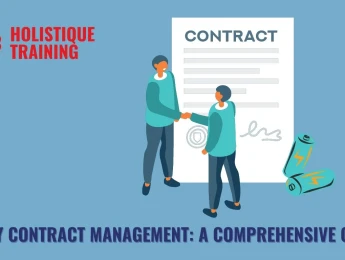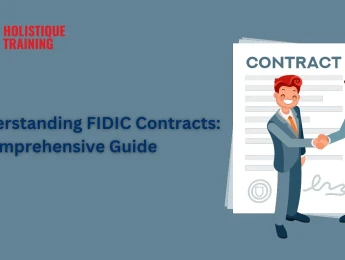- Table of Contents
- Introduction
- What Are Energy Contracts?
- Power Purchase Agreements (PPA)
- Energy Supply Agreements
- Direct Access Energy Agreements
- Distribution Agreements
- Lease Exchange Agreements
- Exploration and Development Agreements
- Joint Operating Agreements
- What Is Energy Contract Management?
- Why Is Energy Contract Management Important?
- 1. Risk Mitigation
- 2. Financial Stability and Cost Control
- 3. Regulatory Compliance
- 4. Operational Efficiency
- 5. Long-Term Strategic Planning
- The Process of Contract Management in the Energy Industry
- 1. Contract Drafting and Negotiation
- 2. Contract Review and Approval
- 3. Contract Execution
- 4. Performance Monitoring
- 5. Amendments and Renegotiations
- 6. Renewal or Termination
- Challenges of Energy Contract Management
- Market Volatility
- Regulatory Changes
- Contract Complexity
- Environmental Concerns
- Long-Term Nature
- Best Practices in Energy Contract Management
- 1. Use Contract Management Software
- 2. Regular Audits
- 3. Stay Updated on Regulations
- 4. Build Flexibility into Contracts
- 5. Ensure Sustainability Alignment
- 6. Effective Communication
- Conclusion
Introduction
Managing energy contracts is becoming increasingly critical for organisations operating in industries that rely heavily on energy resources. As energy markets evolve and become more complex, ensuring efficient, transparent, and legally sound contract management can significantly affect a company's bottom line. This guide delves into the key aspects of energy contracts, from understanding different types to exploring the importance of energy contract management, the processes involved, common challenges, and best practices to follow.
What Are Energy Contracts?
Energy contracts are legal agreements that outline the terms and conditions under which energy is produced, supplied, distributed, or consumed. These contracts form the foundation of transactions within the energy sector, ensuring that all parties involved are protected by clearly defined responsibilities, pricing structures, and timelines. The nature of energy contracts is diverse, covering different types of energy sources such as oil, gas, coal, renewable energy, and electricity. Each type of energy contract has its unique complexities and regulatory requirements, making contract management essential for preventing disputes, ensuring compliance, and securing long-term financial stability.
Energy contracts are vital for energy producers and consumers, providing a structured framework for managing energy-related transactions. For example, energy producers, such as solar or wind farms, rely on contracts to secure revenue by selling electricity to utilities or large corporations. Conversely, consumers—be they commercial, industrial, or residential—use contracts to lock in energy prices, ensuring cost predictability and access to a reliable energy supply.
Exploring the most common types and their specific applications is important to better understand the diversity within energy contracts. Below are the major types of energy contracts, each serving a distinct function within the energy supply chain:
Power Purchase Agreements (PPA)
Power Purchase Agreements (PPAs) are perhaps the most prominent type of contract in the energy sector, especially within the renewable energy landscape. A PPA is a long-term agreement between an energy generator (such as a solar farm, wind farm, or biomass plant) and an energy buyer (usually a utility company, large corporation, or government entity). The buyer agrees to purchase a set amount of energy at a predetermined price over a specific period, often spanning 10 to 25 years.
PPAs are popular because they benefit both parties: the energy producer secures a stable revenue stream, which helps finance project development and operations, while the buyer locks in a stable energy price, often below market rates, for years. PPAs are particularly important for renewable energy projects, where upfront capital investments are high, and the payback period is long. By having a PPA in place, renewable energy developers can secure financing from investors, as they demonstrate a predictable cash flow over the contract period.
Additionally, many organisations are turning to PPAs as part of their sustainability initiatives, using them to purchase renewable energy directly and reduce their carbon footprints. This is especially common with corporations seeking to meet environmental, social, and governance (ESG) goals, as PPAs can align with broader sustainability objectives.
Energy Supply Agreements
Energy Supply Agreements (ESAs) are contracts between an energy supplier (often a utility or an independent power producer) and a consumer. These contracts outline the terms under which energy—typically electricity or natural gas—is delivered, including pricing, volume, and duration. Energy supply agreements are often tailored to meet the specific energy needs of the consumer, particularly for businesses or industrial operations with high energy demands.
ESAs are common in both regulated and deregulated markets. They allow businesses to secure energy at a pre-negotiated price, protecting them from market fluctuations. For energy suppliers, these contracts provide a reliable source of revenue and often come with performance metrics such as guaranteed energy delivery and service quality.
Consumers can choose their energy supplier in a deregulated energy market, leading to more competitive pricing and customised contract terms. Large industrial companies often negotiate energy supply agreements to optimise their energy costs and ensure reliability, which is critical to maintaining operations.
Direct Access Energy Agreements
Direct Access Energy Agreements allow large commercial or industrial consumers to bypass traditional utility companies and purchase energy directly from independent energy suppliers. These agreements are possible in deregulated markets where consumers can source energy from a competitive marketplace rather than being restricted to a single utility provider.
The primary advantage of direct access agreements is cost savings. Companies can often negotiate lower rates by directly purchasing energy from an independent supplier, particularly if they can time their purchases with favourable market conditions. These agreements also provide more control over the type of energy being sourced, enabling companies to prioritise renewable energy and align with corporate sustainability goals.
However, direct access agreements require sophisticated contract management and a deep understanding of the energy market, as companies need to actively monitor energy prices and manage the risks associated with market volatility.
Contract Type | Key Features | Common Use |
Power Purchase Agreement (PPA) | Long-term energy purchase at fixed prices |
Renewable energy projects |
Energy Supply Contract | Agreement for regular energy delivery from suppliers | Utilities and large businesses |
Direct Access Energy Agreement | Consumers buy energy directly from the market | Businesses seeking market-based energy pricing |
Distribution Agreement | Energy delivery from producers to consumers | Utility companies and energy distributors |
Lease Exchange Agreement | Energy delivery from producers to consumers | Oil and gas production |
Exploration and Development Agreement | Exploration of energy resources for future development | Oil, gas, and renewable energy sectors |
Table 1: Comparison of Different Types of Energy Contracts
Distribution Agreements
Distribution Agreements are critical for ensuring energy delivery from production sites to end consumers. These contracts outline the terms under which energy—whether electricity, natural gas, or petroleum—is transported through infrastructure such as pipelines, transmission lines, or distribution networks.
A separate entity from the energy producer often handles energy distribution, particularly in markets where generation, transmission, and distribution are separated. Distribution agreements ensure that energy is delivered efficiently, reliably, and safely, with clearly defined responsibilities for both the distributor and the producer or supplier.
For example, in the electricity sector, distribution agreements are essential for connecting power generation facilities—such as coal plants or wind farms—with the electrical grid, which then delivers the power to homes, businesses, and industrial sites. These agreements typically specify the conditions under which energy is transported, including capacity, maintenance responsibilities, and regulatory compliance.
Lease Exchange Agreements
Lease Exchange Agreements are primarily used in the oil and gas industry, where energy companies lease land from property owners to explore, develop, and extract resources. These agreements typically involve a payment structure that includes upfront lease payments and ongoing royalties based on the amount of energy produced.
In a lease exchange agreement, the landowner grants the energy company the right to explore and extract resources like oil, natural gas, or coal. In exchange, the energy company agrees to certain financial terms and environmental protections. These contracts are highly detailed, covering the financial aspects and the energy company's environmental and operational obligations.
Such agreements are critical in resource-rich areas where multiple stakeholders may be interested in land use. Lease exchange agreements help manage resource extraction's legal and operational complexities, ensuring that all parties are fairly compensated and that environmental regulations are met.
Exploration and Development Agreements
Exploration and Development Agreements (EDAs) are contracts that govern the activities of energy companies involved in exploring new energy resources, such as oil, gas, or renewable energy projects. These agreements outline the terms under which a company can explore a specific area for energy resources, including financial arrangements, exploration methods, and compliance with environmental regulations.
For instance, in the oil and gas sector, EDAs grant energy companies the right to explore a geographical area to assess the potential for oil or natural gas extraction. The contract may also specify the terms for transitioning from exploration to development, including any royalties or taxes owed to landowners or government entities.
EDAs are important because they balance energy exploration's financial and environmental risks. The contract often includes clauses that address potential environmental impacts, legal liabilities, and performance expectations for energy companies, ensuring that resource extraction is done responsibly and in compliance with applicable laws.
Joint Operating Agreements
Joint Operating Agreements (JOAs) are often used in large-scale energy projects that involve multiple stakeholders. These contracts outline how the parties involved will share the costs, risks, and rewards of developing and operating an energy project. JOAs are common in oil and gas ventures, where different companies may collaborate to explore and develop large reserves.
JOAs provide a framework for decision-making, cost-sharing, and profit allocation among the participating companies. These agreements typically designate one company as the operator responsible for the day-to-day management of the project, while the other partners contribute capital and share in the profits.
The complexity of joint operating agreements requires clear communication and detailed contract terms. Disputes can arise over project management, costs, or production targets, making careful drafting and contract oversight essential to ensuring smooth collaboration between partners.
Energy contracts, regardless of type, are essential for governing the flow of energy resources through every stage of the supply chain, from exploration and production to distribution and consumption. Managing these contracts effectively is critical for both operational success and financial stability in the energy sector. By understanding the different types of energy contracts, companies can better navigate the complexities of the energy market and ensure their business objectives are met while complying with regulatory and environmental standards.
What Is Energy Contract Management?
Energy contract management is the process of overseeing and administrating energy-related agreements throughout their lifecycle. It includes drafting, negotiating, executing, monitoring, and renewing energy contracts to ensure compliance with legal, financial, and operational terms.
Managing energy contracts effectively requires a deep understanding of the energy industry, meticulous attention to detail, and managing complex, multi-party agreements. As energy contracts can often span years or even decades, monitoring these agreements regularly is essential to ensure they meet current legal and regulatory standards.
KPI | Description |
Contract Compliance Rate | Percentage of contracts meeting regulatory and legal standards |
Cost Savings Achieved | Total cost reductions realised through effective contract management |
Timeliness of Contract Execution | Percentage of contracts executed within the agreed timeline |
Risk Mitigation Effectiveness | Level of risks identified and mitigated through contracts |
Supplier Performance Consistency | Supplier adherence to performance, delivery, and quality standards |
Table 2: KPIs of Energy Contract Management
Why Is Energy Contract Management Important?
Energy contract management is pivotal in ensuring the smooth operation of businesses and organisations within the energy sector. The energy industry is highly complex and dynamic, with fluctuating markets, evolving regulatory environments, and intricate supply chains. Effective management of energy contracts provides stability, compliance, and strategic benefits to all parties involved. Whether it is a small business looking to control energy costs, a large utility securing a reliable supply of renewable energy, or a government agency overseeing resource extraction, energy contract management offers a structured framework that safeguards financial interests and operational efficiency.
At its core, energy contract management is important for several key reasons, including risk mitigation, financial stability, regulatory compliance, operational efficiency, and long-term strategic planning. Each factor plays a crucial role in the success and sustainability of energy-related projects.
1. Risk Mitigation
According toWebdox, contracts govern between 60% and 80% of a company’s business transactions, yet many legal departments still manage their life cycles inefficiently. Energy contracts are inherently tied to a variety of risks, including market volatility, operational delays, regulatory changes, and environmental concerns. Proper energy contract management helps to identify, assess, and mitigate these risks early in thecontract lifecycle. By establishing clear terms and conditions, parties can allocate risks appropriately and create contingency plans for unforeseen challenges.
For example, an energy supply agreement may include clauses that address market price fluctuations, ensuring that both the supplier and consumer are protected from dramatic price spikes or drops. Additionally, risk-sharing mechanisms can be built into contracts to ensure that the burden of potential disruptions—such as natural disasters affecting energy production—does not fall entirely on one party.
Without robust contract management, risks can spiral out of control, leading to financial losses, legal disputes, and damaged reputations. By managing risks through well-drafted contracts and constant monitoring, energy companies and their clients can reduce the likelihood of costly disruptions and ensure the long-term viability of their operations.
2. Financial Stability and Cost Control
One of the most significant benefits of energycontract management is its impact on financial stability and cost control. Energy costs can be one of the largest expenditures for businesses, especially in industries with high energy demands such as manufacturing, transportation, and data centres. Energy contracts allow businesses to negotiate terms that provide cost predictability and stability, often for extended periods.
For instance, Power Purchase Agreements (PPAs) are designed to lock in a fixed price for energy over a long-term period, protecting both producers and consumers from volatile market conditions. With effective contract management, companies can optimise their energy procurement strategies by negotiating favourable pricing terms, hedging against market risks, and taking advantage of bulk purchasing opportunities.
Energy contract management also helps companies identify hidden costs or inefficiencies. For example, an organisation might find through contract audits that they are being overcharged for energy or that they can renegotiate certain clauses to achieve more favourable terms. Additionally, by strategically managing when and how contracts are renewed, companies can avoid sudden price hikes and reduce the risk of paying premium rates due to poor timing in the market.
For energy suppliers and producers, contract management ensures that they receive timely payments and maintain a steady cash flow, which is essential for operational sustainability and investment planning. Clear invoicing and payment terms reduce the risk of disputes, late payments, or revenue shortfalls.
3. Regulatory Compliance
Energy is one of the most heavily regulated industries, with a wide array of local, national, and international laws governing everything from production and distribution to environmental impact and consumer protection. Navigating this complex regulatory landscape requires not only a thorough understanding of the legal environment but also the ability to ensure that contracts are in full compliance with all relevant rules and guidelines.
Energy contract management is essential for ensuring that contracts adhere to the ever-evolving regulatory frameworks. Regulatory non-compliance can result in fines, legal action, or project shutdowns, all of which can be financially devastating and damage the reputation of companies involved.
For instance, energy companies involved in oil and gas extraction must comply with environmental regulations, safety standards, and tax laws. Contracts must account for these legal obligations, clearly outlining responsibilities, penalties for non-compliance, and how environmental and safety measures will be monitored. Similarly, renewable energy projects must comply with zoning laws, grid connection requirements, and subsidies or tax incentives.
Properly managed energy contracts ensure that all stakeholders understand and adhere to their regulatory responsibilities, reducing the likelihood of legal issues or costly delays. By integrating compliance into the contract management process, energy companies can focus on growth and innovation without being hindered by regulatory roadblocks.
4. Operational Efficiency
Energy contract management also promotes operational efficiency by ensuring that all parties involved in energy production, distribution, or consumption understand their roles, responsibilities, and performance expectations. Contracts provide a clear roadmap for how energy projects will be executed, from the exploration phase through to distribution and delivery.
Well-managed contracts prevent misunderstandings and disputes by ensuring that all terms—such as timelines, maintenance requirements, and performance benchmarks—are clearly defined. This clarity allows energy projects to proceed smoothly, with fewer disruptions or delays. For instance, a distribution agreement in the electricity sector might specify the capacity and timelines for delivering energy from a power plant to end consumers, ensuring that the infrastructure is adequately maintained and that service levels are met.
Energy contract management also helps optimise resource allocation. By analysing contract performance and obligations, companies can better plan for staffing, equipment needs, and supply chain logistics. For example, a company managing multiple contracts across different regions can use contract management tools to ensure that resources are appropriately allocated to meet obligations without overextending operations.
Efficiency in contract management also translates into improved project management. Whether it’s tracking the progress of energy infrastructure development or monitoring energy delivery under supply agreements, effective contract management ensures that companies meet their deadlines and performance targets, avoiding penalties and fostering better relationships with stakeholders.
5. Long-Term Strategic Planning
Energy contract management is essential for long-term strategic planning and sustainability. Contracts are often tied to multi-year agreements, particularly in renewable energy development or exploration of oil and gas. As energy companies plan for the future, they need to ensure that their contracts align with their broader business objectives, whether that involves expanding into new markets, transitioning to renewable energy, or securing long-term energy supply for key operations.
Effective contract management enables companies to take a proactive approach, identifying opportunities for growth and improvement. For example, by analysing the performance of existing contracts, an energy company might decide to invest more heavily in solar or wind power, renegotiate contracts to include sustainability clauses, or enter new agreements that focus on carbon reduction targets.
Additionally, energycontract management is crucial for adapting to market changes, technological advances, or shifts in regulatory policy. With a clear understanding of existing contracts and their implications, companies can make informed decisions about how to pivot when faced with industry changes, such as transitioning from fossil fuels to renewables or adopting new technologies like energy storage.
For energy consumers, particularly large corporations, contract management plays a role in achieving long-term sustainability goals. By integrating renewable energy into their procurement strategies through Power Purchase Agreements or direct access energy contracts, businesses can work toward reducing their carbon footprint and meeting sustainability targets while maintaining operational and financial stability.
Energy contract management ensures that all stakeholders in the energy sector—whether producers, distributors, or consumers—are equipped to navigate the complexities of energy transactions in a way that mitigatesrisks, ensures compliance, optimises operations, and supports long-term strategic objectives. Through efficient and effective management, companies can protect their financial interests, maintain regulatory adherence, and prepare for the evolving demands of the energy market.
The Process of Contract Management in the Energy Industry
Managing energy contracts involves multiple stages, from initiation to renewal or termination. Each stage requires careful attention to detail and ongoing oversight. Below is a step-by-step outline of the contract management process in the energy industry:
1. Contract Drafting and Negotiation
The process begins with drafting the contract, often after detailed discussions between the involved parties. Drafting involves defining terms such as pricing, delivery schedules, responsibilities, penalties, and performance guarantees. Both parties aim to secure the best terms during the negotiation phase while ensuring fairness and feasibility.
2. Contract Review and Approval
Once the draft is prepared, it undergoes an internal review by legal and operational teams. The contract is then approved by the decision-makers within the organisation. In large-scale contracts, this might involve a multi-tiered approval process with input from stakeholders across various departments.
3. Contract Execution
After approval, the contract is signed by both parties and becomes legally binding. This phase may include setting up compliance systems to ensure the contract terms are followed, such as tracking energy deliveries and payments.
4. Performance Monitoring
Once the contract is in place, monitoring its performance is crucial. This might include tracking energy usage, comparing costs against contract terms, and ensuring the energy supplier meets agreed-upon service levels. Regular audits help ensure compliance and flag any discrepancies that may require corrective action.
5. Amendments and Renegotiations
Contracts often need amendments due to market conditions, regulations, or operational requirements changes. Renegotiation is a critical aspect of contract management, enabling organisations to update terms and maintain relevance throughout the contract’s life.
6. Renewal or Termination
As contracts expire, energy contract managers must decide whether to renew or terminate the agreement. Renewal may involve renegotiating terms, while termination could lead to developing new contracts with other suppliers.
Challenges of Energy Contract Management
Managing energy contracts is fraught with challenges due to the complex, evolving nature of the industry. These challenges include:
Market Volatility
Energy prices can be highly volatile, particularly in the oil and gas sectors. Sudden price shifts can affect contract terms, requiring constant monitoring and flexibility in renegotiation.
Regulatory Changes
Energy regulations are subject to frequent changes at both the regional and global levels. Failing to stay compliant can result in penalties or even contract invalidation, making it critical to keep contracts aligned with current legislation.
Contract Complexity
Energy contracts often involve multiple stakeholders, spanning long timeframes and vast geographical regions. Managing such complex contracts requires legal expertise and technological solutions that track contract performance and obligations.
Environmental Concerns
In an era where environmental responsibility is a key consideration, energy contracts increasingly need to address sustainability. This adds another layer of complexity, especially for companies looking to balance environmental goals with profitability.
Long-Term Nature
Energy contracts, particularly PPAs and exploration agreements, often last several decades. This long-term nature can pose challenges when unforeseen market conditions or technology changes arise, making previously agreed-upon terms less favourable.
Best Practices in Energy Contract Management
Effective energy contract management demands strategic planning, continuous monitoring, and adherence to best practices. Below are some best practices for ensuring efficient management:
1. Use Contract Management Software
Technology plays a crucial role in managing complex energy contracts. Specialisedcontract management software can automate tracking, alert stakeholders to upcoming milestones, and ensure compliance with all contractual obligations.
2. Regular Audits
Conducting regular audits ensures that both parties adhere to the contract terms. This proactive approach can identify potential issues before they become significant problems, allowing for adjustments as needed.
3. Stay Updated on Regulations
Energy contract managers must remain up-to-date on the latest regulatory changes. Developing strong relationships with legal teams and external consultants can help ensure that contracts stay compliant.
4. Build Flexibility into Contracts
Given the long-term nature of many energy contracts, it’s essential to build in flexibility. Including clauses for renegotiation or revision allows for adjustments in response to changing market conditions, regulations, or technological advances.
5. Ensure Sustainability Alignment
Incorporating sustainability considerations into energy contracts is becoming increasingly important. Companies should ensure that contracts align with their environmental goals, particularly when negotiating renewable energy agreements.
6. Effective Communication
Maintaining clear communication between all parties involved in the contract is key to ensuring smooth execution. Contract managers should regularly check in with both the internal teams and external partners to keep everyone aligned.
Conclusion
Energy contract management is essential to ensuring operational efficiency, risk management, and compliance within the energy industry. From the initial drafting and negotiation to performance monitoring and contract renewal, careful attention to every stage of the contract lifecycle is crucial. By adhering to best practices and leveraging technological tools, organisations can navigate the complexities of the energy market while securing favourable, long-term outcomes.
To deepen your understanding and become proficient in contract management, enrol in our‘Becoming an Expert in Contract Management’ course. This comprehensive program covers all aspects of contract management, offering practical tools and insights to help you excel. Equip yourself with the skills needed to master the art of contract negotiation, risk management, and strategic planning. Learn more by clicking the link below!
























